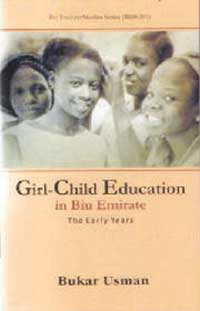President of the Nigerian Folklore Society and former permanent secretary, Dr. Bukar Usman, has taken up the gauntlet in the campaign for girl-child education.
 His 136-page book titled, Girl-Child Education in Biu Emirates: The Early Years, published last year by Klamidas Publishers is reviewed here by Abubakar Ibrahim.
His 136-page book titled, Girl-Child Education in Biu Emirates: The Early Years, published last year by Klamidas Publishers is reviewed here by Abubakar Ibrahim.
Dr. Usman, retired civil servant, history, language and folklore buff, has already established himself as an intellectual and a prolific writer of note with the dozens of books he has written over the last two decades.
As someone who has decided to dig into his roots and project, the history and values of his people, starting the Biu Emirate Studies Series affords him the platform to document the rich history of his native Biu and that emirate’s journey to find itself.
The first in this series, Girl-Child Education in Biu Emirate, comes across as something that Usman is really passionate about. The amount of research that has gone into producing this book and the quality of the finishing (these have become Dr. Usman’s trademark, I dare say) have made this an outstanding work already.
But when one buckles down to the content, an interesting parallel emerges. Biu, as we know, is in Borno State, the Boko Haram-ravaged territory where the terror group has attacked schools, massacred schoolboys and abducted and held for months hundreds of schoolgirls.
But as is graphically demonstrated in this book, the cultural forces militating against girl-child education are not new, but have been prevalent right from the get-go.
The initial battle, as this book demonstrates, has been largely fought and won, save for a few, if in some places still significant skirmishes, until recent unfortunate developments in the guise of insecurity and the targeting of students and schools in the on-going insurgency.
Girl-Child Education has only 136 pages and seven chapters. But it can be broadly categorised into two parts; the first documents the history, background and challenges of girl-child education in Biu (and education in this context, refers to formal education of girls, for Dr. Usman demonstrates that there were socio-cultural channels by which girls were educated to fill their society-defined roles in Biu before the advent of colonial influences), while the second part of the book serves up a profile of the pioneer girls that ventured into formal schools in the late 1930s and how most of them fared in their family and professional lives.
But when one considers that Biu Division was created in 1918 and a school for adults was established by a colonial officer in that year (p26) and between 1923 and 1957 some 23 schools were established, it is surprising to note that it was only in 1938 that Malama Hauwa Kachalla Yamta became the pioneer girl student at Biu Central Primary School (p42).
It is true that the people of the North shielded their wards from western education due to cultural and religious reasons, but it is also true that western education was rather late in arriving the North, thereby setting the region at a disadvantage.
But for the girls in Biu Emirate, their challenge wasn’t altogether different from others in the region. Getting a formal education was considered to be at odds with the culturally-defined roles women were expected to play in society. In Biu, these included being farm-hands and ultimately housewives and mothers, and for these roles, there were longstanding cultural methods of orientation.
The general perception that western education was in itself deviant did not help. As Usman noted, the first students to be sent to school were mostly the stubborn boys that were mostly considered ungovernable, and when some of them refused and fled to escape being educated, girls were conscripted in their place, as the colonial administration had a policy that everyone working under it must send a child to school.
And this is despite that Biu Emirate happened to be more receptive to western education than other more conservative regions of the North. And where traditional rulers have been known to oppose western education, the case in Biu was remarkably different.
“Traditional and Islamic education, which preceded the British incursion, continued to thrive, but the Kuthli (now Emir) of Biu, under the new colonial arrangement, had become the arrowhead of the recruitment of children into the fledgling primary schools set up by the British administrators. His guards, without parental permission, arrested a number of school-age children on the streets of Biu, took them to the Emir’s palace from where they were immediately sent to school” (p5).
The role of Mai Ali Gugur, the 25th Kuthli of Biu in leading this revolution, is further documented on page 83, and to him, not only the women but the people of Biu should erect a monument (if there isn’t one already).
The profiles of the pioneer female students of Biu Emirates, which Usman painstakingly chronicles and presents, is not only a testament to the achievements of the women of Biu Emirates, against considerable odds, but a beacon of hope to girls and women, especially in the North East, in the trying times that we’ve found ourselves. Many women and girls of this age will find this a valuable vault of material to inspire girl-child education and advocate women’s right to education.
Bukar Usman’s book is an invaluable material for those passionate about women education and historians as well. A truly commendable effort from one of the most prolific writers and researchers abound.
• Ibrahim is an Abuja-based writer and journalist.













